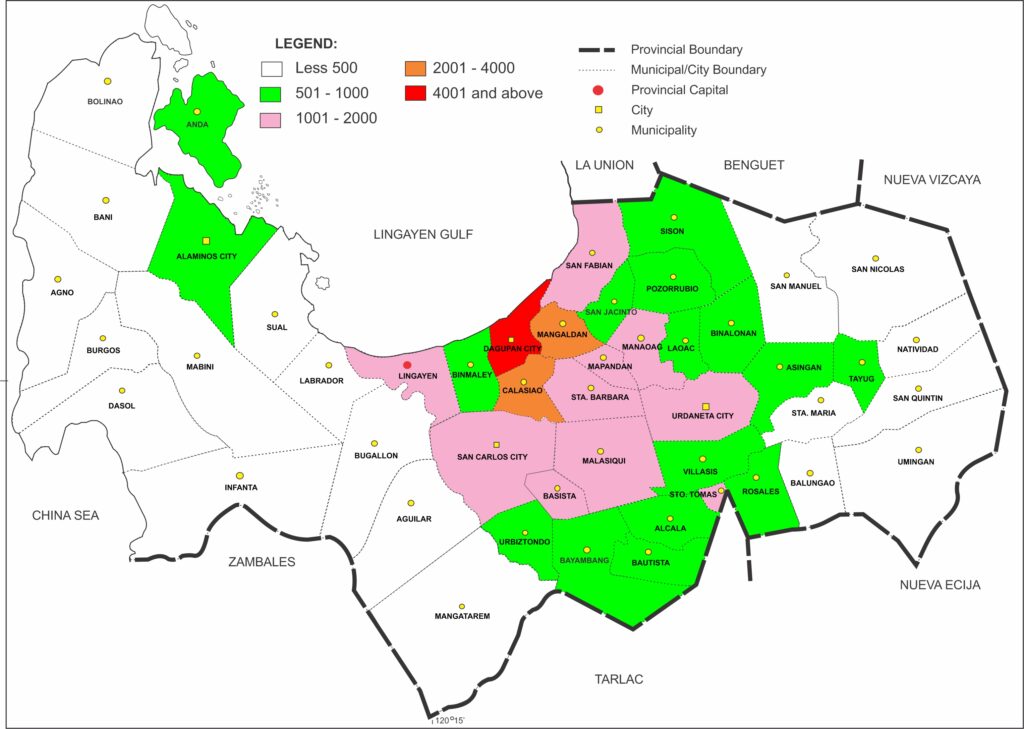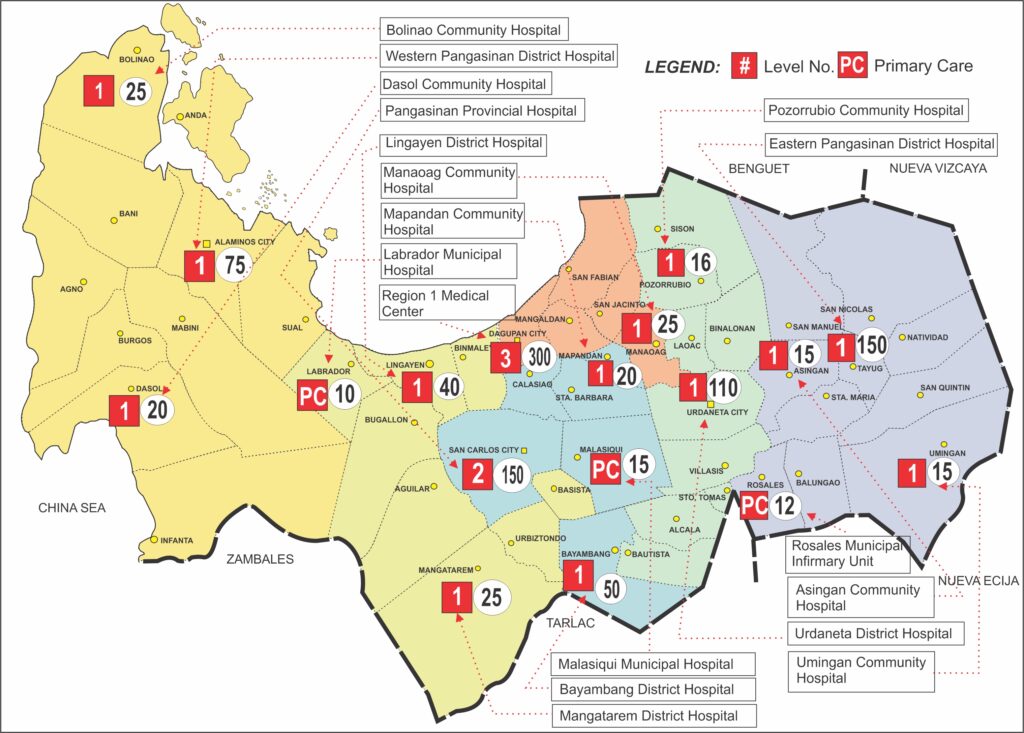Population Size, Growth Rate and Population Density
Based from the 2015 census of population, Pangasinan registered a total population of 2,956,726 and ranks fourth in the country. Among the four (4) cities and forty-four (44) municipalities of Pangasinan, San Carlos City had the largest population with 188,571 persons. This is followed by Dagupan City with 171,271, the City of Urdaneta with 132,940, and the municipalities of Malasiqui with 130,275 and Bayambang with 118,205 number of persons. These two municipalities surpassed the hundred thousand mark in population count higher than the population of Alaminos City of 89,708. On the other hand, the municipality of Sto. Tomas with population of 15,022 persons is the least populated area in 2015 census.
For CY 2019, the province’s projected population registered a total of 3,100,102 with a population density of 569 persons per square kilometer of land . The population density is higher by 5% (542) compared to 2015 census of population. Also, it is higher than the regional and national density of 384 and 337 persons per square kilometer of land, respectively.

The total household population (Census 2015) for both male and female is 2,951,267 wherein 1,489,688 are male and 1,461,579 are female which both gender represent 50% of the total household population.
In terms of the distribution by age and sex, there were more males than females in age group 0 – 54 in 2015 Census with the males comprising 51.0 percent of these age groups. In contrast, there were more females than males in the older age group 55 years old and over. The males in these groups made up of 45.9 percent.
The province’s household population is 2,951,267 and the total number of household is 674,575 with an average household size of 4.4.
Based on the average annual growth rate of 1.85%, the projected number of households is 726,855, which shows an increase of 1.02% from the previous data.
Based on the 2010 Census, the province has 574 urban barangays with a population of 1,458,402 and 790 rural barangays with a population of 1,321,460.
Health
In 2018, there were a total of 60 public and private hospitals with a total number bed capacity of 1,121 for government and 1,219 for private hospitals.

As per DOH data, there were 90 birthing homes established in the province. These healthcare facilities were lodged in private hospitals and Rural Health Units.
In addition, the province had 63 Rural Health Units (RHUs) and 613 Barangay Health Stations (BHS) complementing health service delivery to the populace.
From the different health services catered by different government hospitals, there were 88 doctors, 305 nurses, 49 dentists, 527 midwives, 18 nutritionist/dieticians and 68 medical technologist providing health care and medical treatment to various patients.
Acute Respiratory Infection was the most prevalent morbidity case in the province registering 207,809 (CY 2019) cases which went up by 45.43% of the 142,889 cases in the previous year (CY 2018). On the other hand, Heart Diseases continue to be the leading cause of mortality in the province in 2019, increased by 39% or 935 deaths from 2,406 total number of deaths in 2018 to 3,341 deaths for the period under review. Pneumonia and Cancer followed, claiming 1,867 and 1,164 lives respectively
The number of livebirths went down by 90% from 45,966 in 2018 to 24,191 in 2019 with crude birth rate of 8.29 (per 1,000 population). Meanwhile, the number of registered deaths decrease by 4.09% from 12,014 registered deaths in 2018 to 11,522 in 2019 with a crude death rate of 3.95.
Social Welfare
The province had 1,470 child development centers/day care centers providing early childhood care and development to children 3-5 years old. A total of 52,214 day care children were (26,283 boys and 25,931 girls) served by 1,506 accredited day care workers providing day care services.
The province had a total of 243,355 senior citizens excluding Dagupan City. Of these, 98,132 (40%) are males and 147,091 (60%) are females.
Education
Public elementary enrolment slightly decreased from 418,641 in the previous school year to 385,623 this SY 2019-2020 with a minimum percentage of 5.84%. Secondary enrolment meanwhile, decreased by 0.44% from 228,127 to 227,114 enrollees.
Pangasinan had sufficient public school teachers as evidenced by the teacher-pupil ratio of 1:25 for both elementary and secondary level as against the planning standard of 1:45 for SY 2019-2020. On the other hand, the classroom-student ratio is 1:27 and 1:30 for elementary and secondary respectively.
As per data from the different DepEd Divisions (SY 2019-2020), the province have recorded a total of 296 government and 157 private schools teaching senior high school. From these schools, total students enrolled under government institutions were 111,031 while private schools totaled to 25,760. This means that out of the 259,648 Junior High School from public and private school last year, a total of 130,427 students did not enroll in Senior High School in the province.
Based from the Commission on Higher Education’s (CHED) report, there are 61 tertiary schools providing various courses of higher education in the province. A total of 90,685 students were enrolled for SY 2019-2020. An increase of 10.05% compared to its previous figure of 82,403.
Meanwhile, TESDA provincial office reported a total of 84 technical-vocational schools with a total enrolment of 11,435 (SY 2018-2019) showing a decrease of 305 or 3% compared to SY 2017 – 2018. The decrease may be attributed to the presence of Senior High School wherein one of its track is Technical-Vocational and Livelihood.
Employment
This year’s province employment rate is 94.71%, while the unemployment rate and underemployment rate is 5.29% and 16.95% respectively. While, the labor force participation rate of Pangasinan is 62.39% which comprises the total employed and unemployed population.
Based from the DOLE – RO1, the daily minimum wage rate for agriculture and non-agriculture industries/sectors ranges from P282.00 to P340.00 as per Wager Order No. RB 1-20. Effectivity date of this wage rate is on April 30, 2019.
Poverty Incidence
As per the Philippine Statistics Authority (PSA) survey, poverty incidence among families in Pangasinan continue to decrease from 16.9% in 2015 Annual Poverty Incidence and further reduced to 9.3% in 2018. The annual per capita poverty threshold of the province increased from P22,799 (CY 2015) to P27,828 (CY 2018).
Protective Service
The total number of PNP Officers and Police Non-Commission Officers serving the province totaled to 2,670 personnel. From this number, 2,553 are non-officers (including the non-uniform personnel) and 117 are officers.


